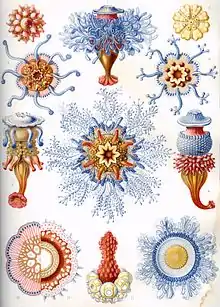Hydroidolina
Hydroidolina is a subclass of hydrozoans in the phylum Cnidaria. It contains the bulk of the paraphyletic "Hydroida" which were one of the main groupings of the class Hydrozoa in older classifications and were placed at order rank. Hydroidolina also includes, however, the highly advanced colonial jellies of Siphonophora, which were not included in the "Hydroida".[1]
| Hydroidolina | |
|---|---|
 | |
| Siphonophorae from Ernst Haeckel's 1904 Kunstformen der Natur | |
| Scientific classification | |
| Kingdom: | Animalia |
| Phylum: | Cnidaria |
| Class: | Hydrozoa |
| Subclass: | Hydroidolina Marques & Collins, 2004 |
| Orders | |
| Synonyms | |
| |
Taxonomy and systematics
The classification below is based on the World Register of Marine Species:[2]
Subclass Hydroidolina
- Order Anthoathecata
- Order Leptothecata
- Order Siphonophorae
Alternate classifications
Other hydrozoan classifications, which are beset by paraphyly however, are still often seen. They do not unite the Leptolinae in a monophyletic taxon and thus do not have any merit according to modern understanding of hydrozoan phylogeny. The alternate name Leptolinae (or Leptolina) was used in older sources for Hydroidolina.
The obsolete name Hydroida was used for a paraphyletic grouping that is now considered synonymous with Hydroidolina but did not include the colonial jellies of the order Siphonophorae.
References
- Peter Schuchert (2005). "Hydrozoan Phylogeny and Classification". The Hydrozoa Directory. Retrieved July 8, 2008.
- "WoRMS - World Register of Marine Species - Hydroidolina". marinespecies.org. Retrieved 2018-03-15.
